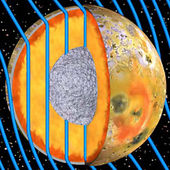
Io's center is in constant flux: Jupiter's enormous gravity pulls on the moon's "slushie-like interior," UCLA geophysicist Krishan Khurana says, and all that friction produces an enormous amount of thermal energy, through what's called tidal heating. The heat melts rock to create magma, which spews out of the 400 or so volcanoes on Io's crust. Previously, however, scientists weren't sure exactly how that magma was distributed. Some thought it might have come from isolated underground pockets or wellsprings, as is the case on Earth, rather than a global layer of magma.
Research published today in the journal Science may put that theory to rest. Khurana's team revisited data from a magnetometer aboard the Galileo spacecraft, which flew by Jupiter and its moons a decade ago. Their analysis - based on a new understanding of how to interpret changes in magnetic fields - captured the distinct signature of the sea of scalding magma lying below Io's surface, the first time direct measurements have determined its existence.
Jupiter produces a strong electromagnetic field that passes through Io's interior, creating the signature that Galileo recorded. But because Galileo didn't orbit Io - the craft only flew by it - it was difficult for scientists to distinguish the signals that passed through the moon from the ones that came directly from Jupiter. Once Khurana's team worked out the tiny variations in qualities such as amplitude that should come from Jupiter's field passing through Io, they realized they could be explained only by a moon-wide pool of conductive material - in this case, partially molten rock. In addition, the researchers modeled the magnetic effects they would expect from a global shell of underground magma, and it matched their measurements from Io. "A liquid layer is required somewhere in Io that causes the electromagnetic response we measured," Khurana says. His calculations indicate the magma is at least 20 percent liquid and more than 30 miles thick.
This isn't the first time scientists have used these slight electromagnetic changes to see inside a moon. The same kind of electromagnetic analysis was used to demonstrate the likely existence of oceans of liquid water on Jupiter's moons Europa, Ganymede and Callisto. Like molten rock, salt water has high conductivity, which responds to Jupiter's electromagnetic radiation in a similar manner. "This is what we should have probably expected because the same type of result came from [Jupiter's] icy satellites, which have salty water oceans," says Alfred McEwen, a planetary geologist at the University of Arizona who has studied Io. These insights on the inner workings of Io and its neighboring moons - where tidal heating melts ice - could help scientists better gauge how much liquid water to expect on Europa, where scientists place hope that life could exist. Volcanic activity on Io and likely reservoirs of magma on Jupiter's other moons could also be a potential source of energy for future explorations or even habitation of the solar system, McEwen says.
Meanwhile, Io still poses more questions. One reason that scientists entertained the idea of pockets of magma rather than a global layer was that this view helped to explain how the moon's structure could support its 100 or so mountains - the most impressive of which reaches 10 miles high (so tall it would tower over Mount Everest). With a full layer of magma beneath its surface, how Io supports those mountains isn't entirely clear. "[They] pose real challenges for people trying to figure out the inside of Io," says Laszlo Kestay, who studies astrogeology with the U.S. Geological Survey in Flagstaff, Ariz.
Though Io is similar to Ganymede in many respects, it lacks a magnetic field - which is strange, since both possess the dense iron core that should give rise to one. Khurana and colleagues hypothesize that Io's semi molten mantle is so hot that it doesn't allow the core to cool. This cooling is necessary for the internal convection that creates a magnetic field.
Io could also teach us a lot about our planet's early days. Geologic evidence suggests that billions of years ago, the Earth was rife with volcanic activity and probably had its own worldwide magma ocean, Khurana says. Better grasping Io's evolution could lead to a more thorough understanding of primitive Earth and the forces that created the planet we know today, Kestay says.
That's why McEwen wants to go back. He applied to NASA's Discovery program for funding to build a craft that would observe and take measurements of Io. He learned last week that his project wasn't chosen, but he plans to apply again for the next round, which will probably take place in two to three years. He also intends to apply to NASA's New Frontiers program, another potential source of funding.
"Io is not the kind of place you can see once and know," Kestay says. "It's constantly evolving and changing."



Reader Comments
to our Newsletter